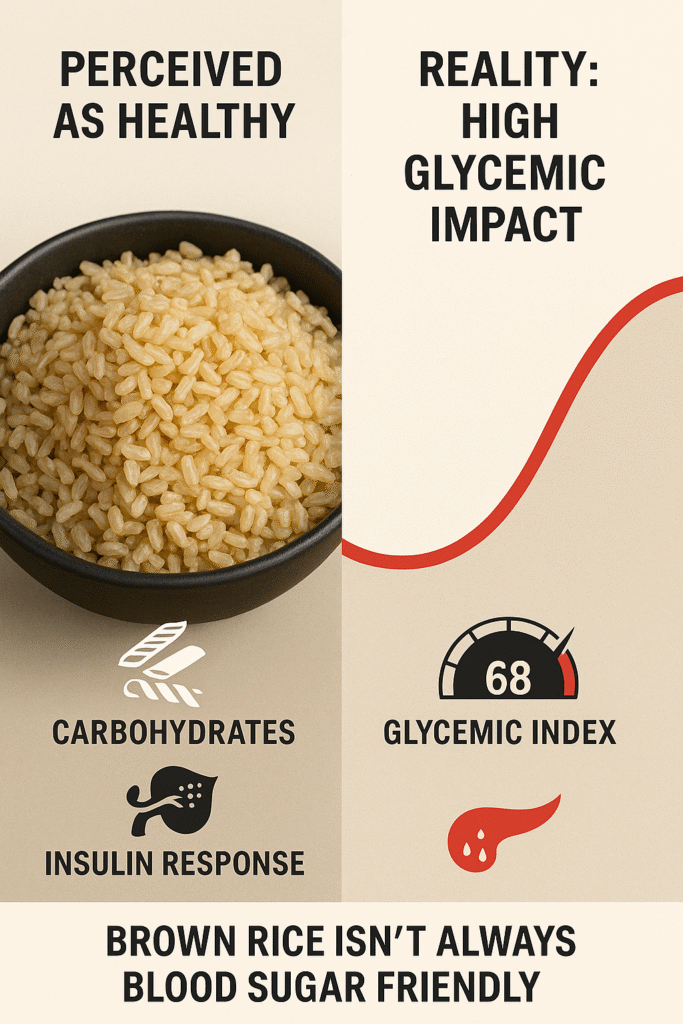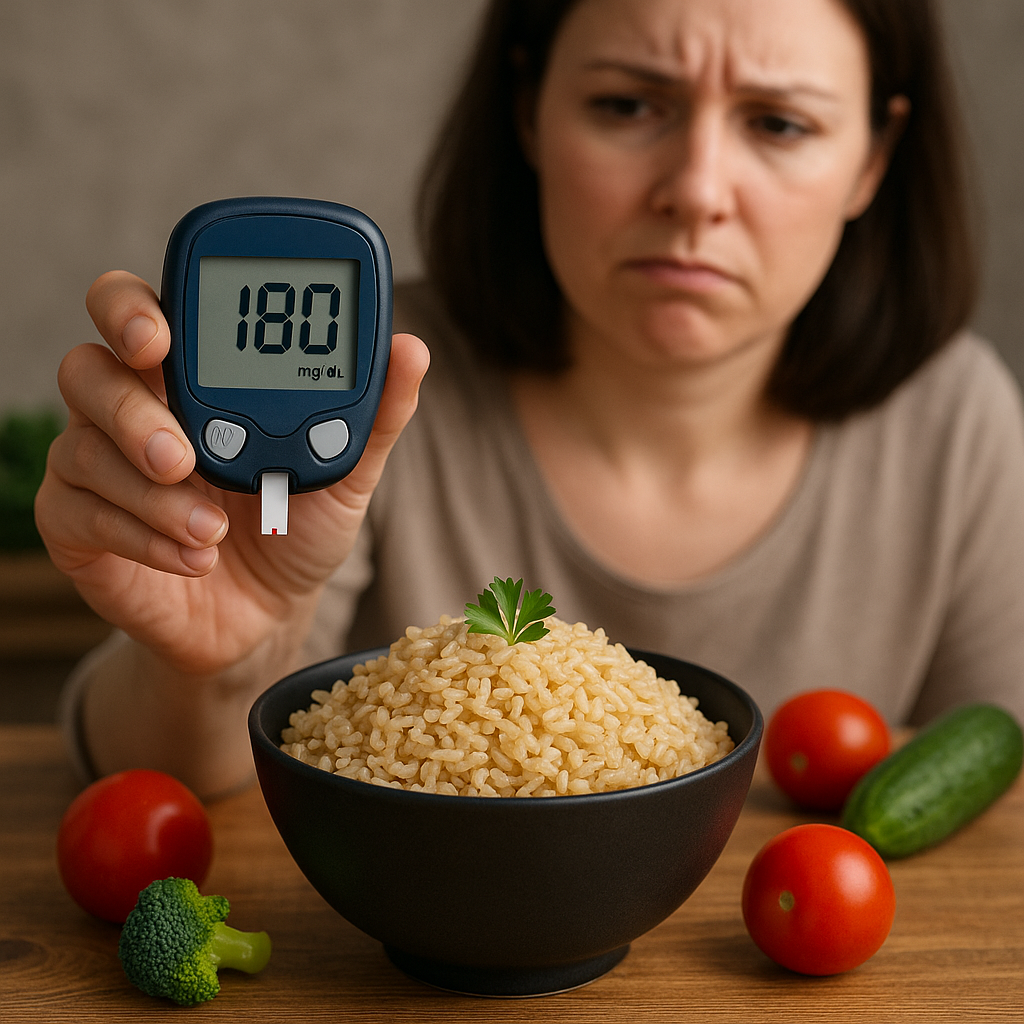One question I get asked almost every week is:
“Is brown rice good for diabetes?”
Most people assume it’s the healthier option. But if you’re working toward diabetes reversal, this assumption could be holding you back. Let’s explore the truth.
What is Brown Rice?
Brown rice is whole grain rice with the outer bran and germ layers intact. Because it’s less processed than white rice, many believe it’s healthier.
But the critical question remains:
Is brown rice good for diabetes, especially when your goal is reversal—not just control?
The short answer is: not really.
How is Brown Rice Processed?
Brown rice is made by removing only the outer husk of the rice kernel, keeping the bran and germ. This retains fiber and nutrients—but it does not reduce the high starch load. Brown rice is still a carbohydrate-heavy food, which is problematic for diabetics.
Nutritional Profile: Why Brown Rice is a Problem for Blood Sugar
Per 100g (cooked) of brown rice:
- Carbohydrates: ~23g
- Protein: ~2.5g
- Fat: ~0.9g
- Fiber: ~1.8g
- Calories: ~110 kcal
Brown rice is nutritionally similar to white rice in its carbohydrate load. Despite slightly higher fiber, it still spikes glucose due to rapid digestion and high net carbs.
Glycemic Index of Brown Rice

The glycemic index (GI) of brown rice ranges from 50 to 87. While this appears moderate, the glycemic load (GL)—based on typical Indian servings—remains high.
Even small amounts can cause post-meal blood sugar spikes, especially in insulin-resistant individuals.
The Impact of Brown Rice on Blood Sugar Levels
Let’s be real: brown rice is mostly starch.
- It spikes blood glucose
- It triggers insulin surges
- It offers low satiety, making you hungry sooner
At Redial Clinic, we’ve consistently seen patients plateau in their diabetes reversal when brown rice is kept in the diet. This adds further evidence to the concern—is brown rice good for diabetes, or is it misleadingly marketed?
Brown Rice and Diabetic Patients: A Mismatch
As the Best Nutritionist in Delhi, I’ve worked with hundreds of diabetic patients. The pattern is clear:
Switching from white to brown rice does not improve HbA1c or fasting sugar levels.
The glucose response is still too strong to support diabetes reversal, which is our clinic’s core goal.
Brown Rice vs White Rice: A Minor Upgrade
| Feature | White Rice | Brown Rice |
|---|---|---|
| GI (Glycemic Index) | 72–89 | 50–87 |
| Fiber | ~0.4g | ~1.8g |
| Net Carbs (100g) | ~28g | ~23g |
| Micronutrients | Low | Moderate |
| Blood Sugar Impact | High | Still high |
Conclusion: Brown rice is only marginally better than white rice—but still not suitable for diabetics aiming for reversal.
Why Brown Rice Can Be Harmful in Diabetes Reversal
- High carb content = glucose spikes
- Insulin surges = poor fat burning and worsening resistance
- Health halo = people eat more thinking it’s safe
So again, when you ask, is brown rice good for diabetes, remember: it may not be as healthy as it seems, especially for those reversing insulin resistance.
Myths & Misconceptions
- ❌ Myth: Brown rice is diabetes-friendly
- ❌ Myth: Its fiber cancels out its carbs
- ❌ Myth: Whole grains are always safe for diabetics
Truth: Fiber content is too low to offset the glucose and insulin spike.
Read Also: Why Is My Blood Sugar Still High?
If You Must Eat It
We do not recommend brown rice during active reversal. If a patient insists:
- Limit to 1/3 cup cooked, no more than once a week
- Eat after exercise, not at rest
- Pair with high-protein, high-fiber foods
Even then—it’s a compromise, not a solution.
Final Verdict: Is Brown Rice Good for Diabetes?
No.
Brown rice may be better than white rice—but it still spikes glucose, stimulates insulin, and slows down reversal. It’s not aligned with our goal of nutritional healing.
At Redial Clinic, we advocate Personalized Nutrition for Diabetes Reversal, and brown rice doesn’t make the cut.
FAQs
Is brown rice good for diabetics?
No. It still spikes blood sugar and insulin.
Can brown rice raise blood sugar levels?
Yes. Especially in the usual portion sizes seen in Indian meals.
How often should diabetics eat brown rice?
We recommend avoiding it altogether during the reversal phase.
Take the First Step Toward Reversal
Still wondering, “Is brown rice good for diabetes?” Now you know—it’s not your ally if you’re aiming for healing.
👉 Visit Redial Clinic in Delhi
👉 Book a consultation with the Best Nutritionist in Delhi
👉 Get your Personalized Diabetes Reversal Plan
Because every meal can either heal or harm. Make it count.
References
| No. | Source | Key Insight |
|---|---|---|
| 1 | Meta-analysis of brown rice diets (Rahim et al., 2021) | No significant effect on HbA1c or fasting glucose, but consistent weight loss and increased HDL were noted. |
| 2 | Kristianto et al., 2024 (IJHN) | A dietary formula including brown rice did not significantly reduce blood glucose or HbA1c in diabetics, and LDL levels increased significantly. |
| 3 | Nakayama et al., 2020 (J Nutr Metab) | Among non-diabetics, glutinous brown rice raised 1,5-anhydroglucitol, suggesting modest postprandial benefits, but no change in fasting glucose or insulin. |
| 4 | Panlasigui & Thompson, 2006 (Int J Food Sci Nutr) | Although showing lower glycemic index than white rice, actual glycemic improvements were modest and varied between healthy and diabetic individuals. |
| 5 | Imam & Ismail, 2013 (Mol Nutr Food Res) | Brown rice performed better than white rice in rats, but only germinated brown rice showed meaningful metabolic gene regulation—standard brown rice lacked this. |






